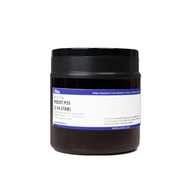AI 4083 PEDOT:PSS
CAS Number 155090-83-8
Materials, Organic Conductors, PEDOT:PSS and PEDOT Polymer BlendsPopular Aqueous PEDOT:PSS Formulation
Used for applications in OPV, OLED, perovskite solar cells, and lighting
Specifications | MSDS | Resources and Support
P VP AI 4083 (CAS number 155090-83-8) is one of the most commonly used aqueous PEDOT:PSS formulations. Due to its deep work function it is often used for the matching of interfacial energy levels in thin film electronic devices. With a PEDOT:PSS ratio of 1:6, AI 4083 has low conductivity with relatively high resistance of 500 to 5000 Ω.cm. It has been widely used in organic and inverted PSCs and OLEDs as a hole transport material.
Deep Work Function
Matching interfacial energy levels
Versatile Use
OPV, OLED, and perovskite solar cells
High Quality
Quality assured material
Low Conductivity
Tailored low conductivity
![]()
PEDOT:PSS (AI 4083) from Ossila was featured in the high-impact paper (IF 56.7), Scalable two-terminal all-perovskite tandem solar modules with a 19.1% efficiency, B. Nejand et al., Nat. Energy, 7, 620–630 (2022): DOI: 10.1038/s41560-022-01059-w; and paper (IF 9.5), Benzophenone: A Small Molecule Additive for Enhanced Performance and Stability of Inverted Perovskite Solar Cells, H. Elbohy et al., ACS Appl. Mater. Interfaces, 15 (38), 45177–45189 (2023); DOI: 10.1021/acsami.3c09835.
Technical Data
| Product Name | Clevios™ P VP AI 4083 |
|---|---|
| Solvent | Water |
| Composition | PEDOT/PSS (1:6 w/w) |
| CAS Number | 155090-83-8 |
| Solid Content | 1.3 – 1.7 wt.% |
| Work Function | 5.0 – 5.2 eV |
| Resistivity | 500 – 5000 Ω.cm |
| Sheet Resistance | +10E6 Ω/sq |
| Conductivity | Low conductivity, 0.0002 – 0.002 S/cm |
| Particle Size Distribution | D90 = 100 nm; D50 = 80 nm |
| Viscosity | 5 – 12 mPa.s |
| pH Value | 1.0 – 2.0 |
| Packaging | 100 ml of solution sealed in a light resistant bottle with temperature indicator |
| Storage | 3 – 5 °C |
Spin Speed Data
 Al 4083 Spin Speed / Film Thickness
Al 4083 Spin Speed / Film Thickness
MSDS Document
Related Products
Resources and Support
 How to Spin Coat PEDOT:PSS
How to Spin Coat PEDOT:PSS
For the deposition of thin films of PEDOT:PSS on a freshly prepared surface, we recommend using a vacuum-free spin coater and following this five-step process:
Read more...PEDOT synthesis involves the oxidative chemical or electrochemical polymerization of EDOT monomer. The choice of counterions and polymerization method significantly affects the conductivity, work function, and stability of the resulting PEDOT polymer.
Read more...
 Al 4083 PEDOT:PSS MSDS Sheet
Al 4083 PEDOT:PSS MSDS Sheet


